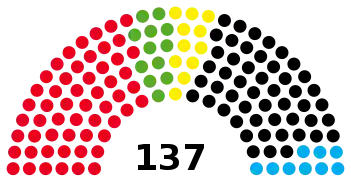Composition of the German state parliaments
Germany's federal system comprises 16 state parliaments (the German terms are: Landtag in large states, Bürgerschaft in Bremen and Hamburg, Abgeordnetenhaus in Berlin), each including directly elected representatives.
 |
|---|
| This article is part of a series on the politics and government of Germany |
|
|
Parties in each parliament
In the table below, the parties with shading form part of the state government whilst the parties in bold are the largest party in that legislature.
| State | Seats (Majority) |
CDU/CSU | SPD | GRÜNE | AfD | LINKE | FDP | Independent | Other | Legislative term | Last election | Next election |
|---|---|---|---|---|---|---|---|---|---|---|---|---|
| Baden-Württemberg | 143 (72) |
43 | 19 | 47 | 18 | - | 12 | 4 | - | 5 years | 2016 | 2021 |
| Bavaria | 205 (103) |
85 | 22 | 38 | 20 | - | 11 | 2 | FW 27 | 5 years | 2018 | 2023 |
| Berlin | 160 (81) |
31 | 38 | 27 | 22 | 27 | 12 | 3 | - | 5 years | 2016 | 2021 |
| Brandenburg | 88 (45) |
15 | 25 | 10 | 23 | 10 | - | - | BVB/FW 5 | 5 years | 2019 | 2024 |
| Bremen | 84 (43) |
24 | 23 | 16 | - | 10 | 5 | 5 | BIW 1 | 4 years | 2019 | 2023 |
| Hamburg | 123 (62) |
15 | 54 | 33 | 7 | 13 | 1 | - | - | 5 years | 2020 | 2025 |
| Hesse | 137 (69) |
40 | 29 | 29 | 18 | 9 | 11 | 1 | - | 5 years | 2018 | 2023 |
| Mecklenburg-Vorpommern | 71 (36) |
18 | 26 | - | 14 | 11 | - | 2 | - | 5 years | 2016 | 2021 |
| Lower Saxony | 137 (69) |
50 | 54 | 12 | 9 | - | 11 | 1 | - | 5 years | 2017 | 2022 |
| North Rhine-Westphalia | 199 (100) |
72 | 69 | 14 | 13 | - | 28 | - | B 3 | 5 years | 2017 | 2022 |
| Rhineland-Palatinate | 101 (51) |
35 | 39 | 6 | 12 | - | 7 | 2 | - | 5 years | 2016 | 2021 |
| Saarland | 51 (26) |
24 | 17 | - | 3 | 6 | - | 1 | - | 5 years | 2017 | 2022 |
| Saxony | 119 (60) |
45 | 10 | 12 | 38 | 14 | - | - | - | 5 years | 2019 | 2024 |
| Saxony-Anhalt | 87 (44) |
31 | 11 | 5 | 21 | 16 | - | 1 | AdP 1, B 1 |
5 years | 2016 | 2021 |
| Schleswig-Holstein | 73 (37) |
25 | 21 | 10 | 4 | - | 9 | 1 | SSW 3 | 5 years | 2017 | 2022 |
| Thuringia | 90 (46) |
21 | 8 | 5 | 22 | 29 | 5 | - | - | 5 years | 2019 | 2024 |
| Total (%) |
1,868 (100) |
574 (30.73) |
465 (24.89) |
264 (14.13) |
244 (13.06) |
145 (7.76) |
112 (6.00) |
23 (1.23) |
41 (2.19) |
Diagrams
 Baden-Württemberg
Baden-Württemberg Bavaria
Bavaria Berlin
Berlin Brandenburg
Brandenburg Bremen
Bremen Hamburg
Hamburg Hesse
Hesse Mecklenburg-Vorpommern
Mecklenburg-Vorpommern Lower Saxony
Lower Saxony.svg.png.webp) North Rhine-Westphalia
North Rhine-Westphalia Rhineland-Palatinate
Rhineland-Palatinate Saarland
Saarland Saxony
Saxony Saxony-Anhalt
Saxony-Anhalt Schleswig-Holstein
Schleswig-Holstein Thuringia
Thuringia
References
This article is issued from Wikipedia. The text is licensed under Creative Commons - Attribution - Sharealike. Additional terms may apply for the media files.
